CHAPTER II.
HILO, WITH SOME VOLCANOES.
Hilo, as you will perceive on the map, lies on the eastern or windward side of the Island of Hawaii. You get there in the little inter-island steamerKilauea, named after the volcano, and which makes a weekly tour of all the Islands except far-off Kauai, which it visits but once a month. The charge for passage is fifteen dollars from Honolulu to Hilo, and twenty-five dollars for the round trip.
The cabin is small; and as you are likely to have fine weather, you will, even if you are a lady, pass the time more pleasantly on deck, where the steward, a Goa man and the most assiduous and tactful of his trade, will place a mattress and blankets for you. You must expect to suffer somewhat from sea-sickness if you are subject to that ill, for the passage is not unlikely to be rough. On the way you see Lahaina, and a considerable part of the islands of Maui and Hawaii; in fact, you are never out of sight of land.
If you start on Monday evening you will reach Hilo on Wednesday—and "about this time expect rain," as the almanac-makers say. They get about seventeen feet of rain at Hilo during the year; and as they have sometimes several days without any at all, you must look for not only frequent but heavy showers. A Hilo man told me of a curious experiment which was once made there. They knocked the heads out of an oil-cask—so he said—and it rained in at the bung-hole faster than it could run out at the ends. You may disbelieve this story if you please; I tell it as it was told me; but in any case you will do well to provide yourself for Hilo and the volcano journey with stout water-proof clothing.
Hilo, on those days when the sun shines, is one of the prettiest places on the Islands. If you are so fortunate as to enter the bay on a fine day you will see a very tropical landscape—a long, pleasant, curved sweep of beach, on which the surf is breaking, and beyond, white houses nestling among cocoa-nut groves, and bread-fruit, pandanus, and other Southern trees, many of them bearing brilliant flowers; with shops and stores along the beach. Men and boys sporting in the surf, and men and women dashing on horseback over the beach, make up the life of the scene.
Hilo has no hotel; it has not even a carriage; but it has a very agreeable and intelligent population of Americans, and you will find good accommodations at the large house of Mr. Severance, the sheriff of Hawaii. If his house should be full you need not be alarmed, for some one will take you in.
This is the usual and most convenient point of departure for the volcano. Here you hire horses and a guide for the journey. Having gone to Hilo on the steamer, you will do best to return to Honolulu by schooner, which leaves you at liberty to choose your point and time of departure. Hawaii lies to windward of Oahu; and a schooner, which might need four or five days to beat up to Hilo, will run down from any part of Hawaii in twenty-four hours. If you are an energetic traveler, determined to see every thing, and able to endure a good deal of rough riding, you may spend six weeks on Hawaii. In that time you may not only see the active volcano of Kilauea, but may ascend Mauna Loa and Mauna Kea, whose immense slopes and lofty and in the winter snow-clad summits show gloriously on a clear day from Hilo; and you may ride from Hilo along the north-eastern coast, through the Hamakua and Kohala districts, ending your journey at Kealakeakua Bay where Captain Cook was killed. There you can take schooner for Honolulu; or if your energies hold out ride through Kau and Puna back to Hilo.
The Hamakua and Hilo coasts you will see from the steamer, which sails close along this bold and picturesque shore on her way to Hilo. This part of the island is but an extension of the vast slope of Mauna Kea; and all the waters which drain from its cloud-laden summit pour into the sea through numerous deep channels, or gorges which they have worn for themselves, and occasionally dash into the ocean from high cliffs, forming water-falls visible from the ship's deck. Of the gorges or cañons, there are seventy-nine in a distance of about thirty miles; many of them are from five to eight hundred feet deep; and as you ride along the coast, you have no sooner emerged from one of these deep pits than you descend by a road seldom easy, and often very steep indeed, into another. The sides of these gorges are lined with masses of the most magnificent ferns, and at their bottoms you find sparkling streams; and as you look up the cañons you see picturesque water-falls. In short, to the lover of bold and strange scenery this ride offers many pleasures; and that its difficulties may not be exaggerated to any one's apprehension, I will mention that during the spring of 1873 an English lady, taking with her only a native woman as guide, made the tour of the whole seventy-nine gulches, and thought herself amply rewarded for her toils by what she saw. As for myself, I must confess that four of these gulches—the four nearest Hilo—satisfied me; these I saw in visiting some sugar-plantations.
If you do not intend such a thorough exploration of Hawaii, but mean only to see the volcano of Kilauea, your pleasantest plan is to ride from Hilo by the direct road to the crater, and return by way of Puna. You will have ridden a trifle over one hundred miles through a very remarkable and in some parts a beautiful country; you will have slept one night in a native house, and will have seen much of Hawaiian life, and enjoyed a tiring but at the same time a very novel journey, and some sights which can not be matched outside of Iceland. To do this, and spend two or three days in pleasant sight-seeing near Hilo, will bring you back to Honolulu in from twelve to fourteen days after you left it.
Your traveling expenses will be sufficiently moderate. At Hilo you pay for board and lodgings eight dollars per week. The charge for horses is ten dollars each for the volcano journey, with a dollar a day for your guide. This guide relieves you of all care of the animals, and is useful in various ways. At the Volcano House the charge for horse and man is five dollars per day, and you pay half-price for your guide. There is a charge of one dollar for a special guide into the crater, which is made in your bill, and you will do well to promise this guide, when you go in, a small gratuity—half a dollar, or, if your party is large, a dollar—if he gives you satisfaction. He will get you specimens, carry a shawl for a lady, and make himself in other ways helpful.
When you get on your horse at Hilo for the volcano, leave behind you all hope of good roads. You are to ride for thirty miles over a lava bed, along a narrow trail as well made as it could be without enormous expense, but so rough, so full of mud-holes filled with broken lava in the first part of the journey, and so entirely composed of naked, jagged, and ragged lava in the remainder, that one wonders how the horses stand it. A canter, except for two or three miles near the Volcano House, is almost out of the question; and though the Hawaiians trot and gallop the whole distance, a stranger will scarcely follow their example.
You should insist, by-the-way, upon having all your horses reshod the day before they leave Hilo; and it is prudent, even then, to take along an extra pair of shoes and a dozen or two horse-nails. The lava is extremely trying to the horse's shoes; and if your horse casts a shoe he will go lame in fifteen minutes, for the jagged lava cuts almost like glass.
Moreover, do not wait for a fine day; it will probably rain at any rate before you reach the Volcano House, and your wisest way is to set out resolutely, rain or shine, on the appointed morning, for the sun may come out two or three hours after you have started in a heavy rain. Each traveler should take his water-proof clothing upon his own saddle—it may be needed at any time—and the pack-mule should carry not only the spare clothing, well covered with India-rubber blankets, but also an abundant lunch to be eaten at the Half-way House.
India-rubber or leather leggings, and a long, sleeveless Mackintosh seemed to me the most comfortable and sufficient guards against weather. Ladies should ride astride; they will be most comfortable thus. There are no steep ascents or abrupt descents on the way. Kilauea is nearly four thousand feet higher than the sea from which you set out; but the rise is so gradual and constant that if the road were good one might gallop a horse the whole distance.
You should set out not later than half-past seven, and make up your mind not to be hurried on the way. There are people who make the distance in six hours, and boast about it; but I accomplished it with a party of ladies and children in ten hours with very little discomfort, and did not envy the six-hour people. There is nothing frightful, or dangerous, or disagreeable about the journey, even to ladies not accustomed to riding; and there is very much that is new, strange, and wonderful to Americans or Europeans. Especially you will be delighted with the great variety and beauty of the ferns, which range from minute and delicate species to the dark and grand fronds of the tree-fern, which rises in the more elevated region to a height of twenty feet, and whose stalk has sometimes a diameter of three or four feet. From a variety of this tree-fern the natives take a substance called pulu, a fine, soft, brown fuzz, used for stuffing pillows and mattresses.
Your guide will probably understand very little English: let him be instructed in your wishes before you set out. The native Hawaiian is the most kind and obliging creature in the world, and you will find your guide ready to do you every needful service. You can get nothing to eat on the road, except perhaps a little sugar-cane; therefore you must provide a sufficient lunch. At the Half-way House, but probably nowhere else, you will get water to drink.
When you reach the Volcano House, I advise you to take a sulphur vapor-bath, refreshing after a tedious ride; and after supper you will sit about a big open fire and recount the few incidents and adventures of the day.
The next day you give to the crater. Unless the night is very foggy you will have gone to sleep with the lurid light of Kilauea in your eyes. Madame Pele, the presiding goddess of the volcano, exhibits fine fire-works at night sometimes, and we saw the lava spurting up in the air above the edge of the smaller and active crater, one night, in a quite lively manner. On a moderately clear night the light from the burning lakes makes a very grand sight; and the bedrooms at the little Volcano House are so placed that you have Madame Pele's fire-works before you all night.
The house stands but a few feet from the edge of the great crater, and you have no tedious preliminary walk, but begin your descent into the pit at once. For this you need stout shoes, light clothing, and, if you have ladies in your party, a heavy shawl for each. The guide takes with him a canteen of water, and also carries the shawls. You should start about nine o'clock, and give the whole day to the crater, returning to dinner at five.
The great crater of Kilauea is nine miles in circumference, and perhaps a thousand feet deep. It is, in fact, a deep pit, bounded on all sides by precipitous rocks. The entrance is effected by a series of steps, and below these by a scramble over lava and rock debris. It is not difficult, but the ascent is tiresome; and it is a prudent precaution, if you have ladies with you, to take a native man for each lady, to assist her over the rougher places, and up the steep ascent. The greater part of the crater was, when I saw it, a mass of dead, though not cold lava; and over this you walk to the farthest extremity of the pit, where you must ascend a tolerably steep hill of lava, which is the bank of the fiery lake. The distance from the Volcano House to the edge of this lake is, by the road you take, three miles.
The goddess Pele, who, according to the Hawaiian mythology, presides over Kilauea, is, as some say all her sex are, variable, changeable, mutable. What I shall tell you about the appearance of the crater and lake is true of that time; it may not have been correct a week later; it was certainly not true of a month before. We climbed into the deep pit, and then stood upon a vast floor of lava, rough, jammed together, broken, jagged, steaming out a hot sulphurous breath at almost every seam, revealing rolls of later lava injections at every deep crack, with caverns and high ridges where the great mass, after cooling, was forced together, and with a steep mountain-side of lava at our left, along the foot of which we clambered.
This floor of lava, which seems likely to be a more or less permanent feature, was, three or four years ago, upon a level with the top of the high ridge, or ledge, whose base you skirt. The main part of the crater was then a floor of lava vaster even than it now is. Suddenly one day, and with a crash which persuaded one or two persons at the Volcano House that the whole planet was flying to pieces, the greater part of this lava floor sank down, or fell down, a depth of about five hundred feet, to the level whereon we now walked. The wonderful tale was plain to us as we examined the details on the spot. It was as though a top-heavy and dried-out pie-crust had fallen in in the middle, leaving a part of the circumference bent down, but clinging at the outside to the dish.
After this great crash the lava seems from time to time to have boiled up from beneath through cracks, and now lies in great rolls upon the surface, or in the deeper cracks. It is related that later the lake or caldron at the farther end of the crater boiled over, and sent down streams of lava which meandered over the black plain; that, continuing to boil over at intervals, this lake increased the height of its own banks, for the lava cools very rapidly; and thus was built up a high hill, which we ascended after crossing the lava plains, in order to look down, in fear and wonder, upon the awful sight below. What we saw there on the 3d of March, 1873, was two huge pits, caldrons, or lakes, filled with a red, molten, fiery, sulphurous, raging, roaring, restless mass of matter, to watch whose unceasing tumult was one of the most fascinating experiences of my life.
The two lakes were then separated by a narrow and low-lying ledge or peninsula of lava, which I was told they frequently overflow, and sometimes entirely melt down. Standing upon the northern bank we could see both lakes, and we estimated their shortest diameter to be about 500 feet, and the longest about one-eighth of a mile. Within this pit the surface of the molten lava was about eighty feet below us. It has been known to sink down 400 feet; last December it was overflowing the high banks and sending streams of lava into the great plain by which we approached it; and since I saw it, it has risen to within a few feet of the top of the bank, and has forced a way out at one side, where, in September, 1873, it was flowing out slowly on to the great lava plain which forms the bottom of the main crater.
What, therefore, Madame Pele will show you hereafter is uncertain. What we saw was this: two large lakes or caldrons, each nearly circular, with the lower shelf or bank, red-hot, from which the molten lava was repelled toward the centre without cessation. The surface of these lakes was of a lustrous and beautiful gray, and this, which was a cooling and tolerably solid scum, was broken by jagged circles of fire, which appeared of a vivid rose-color in contrast with the gray. These circles, starting at the red-hot bank or shore, moved more or less rapidly toward the centre, where, at intervals of perhaps a minute, the whole mass of lava suddenly but slowly bulged up, burst the thin crust, and flung aloft a huge, fiery wave, which sometimes shot as high as thirty feet in the air. Then ensued a turmoil, accompanied with hissing, and occasionally with a dull roar as the gases sought to escape, and spray was flung in every direction; and presently the agitation subsided, to begin again in the same place, or perhaps in another.
Meantime the fiery rings moved forward perpetually toward the centre, a new one re-appearing at the shore before the old was ingulfed; and not unfrequently the mass of lava was so fiercely driven by some force from the bank near which we stood, that it was ten or fifteen feet higher near the centre than at the circumference. Thus somewhat of the depth was revealed to us, and there seemed something peculiarly awful to me in the fierce glowing red heat of the shores themselves, which never cooled with exposure to the air and light.
Thus acted the first of the two lakes. But when, favored by a strong breeze, we ventured farther, to the side of the furthermost one, a still more terrible spectacle greeted us. The mass in this lake was in yet more violent agitation; but it spent its fury upon the precipitous southern bank, against which it dashed with a vehemence equal to a heavy surf breaking against cliffs. It had undermined this lava cliff, and for a space of perhaps one hundred and fifty feet the lava beat and surged into glaring, red-hot, cavernous depths, and was repelled with a dull, heavy roar, not exactly like the boom of breakers, because the lava is so much heavier than water, but with a voice of its own, less resonant, and, as we who listened thought, full of even more deadly fury.
It seems a little absurd to couple the word "terrible" with any action of mere inanimate matter, from which, after all, we stood in no very evident peril. Yet "terrible" is the only word for it. Grand it was not, because in all its action and voice it seemed infernal. Though its movement is slow and deliberate, it would scarcely occur to you to call either the constant impulse from one side toward the other, or the vehement and vast bulging of the lava wave as it explodes its thin crust or dashes a fiery mass against the cliff, majestic, for devilish seems a better word.
Meantime, though we were favored with a cool and strong breeze, bearing the sulphurous stench of the burning lake away from us, the heat of the lava on which we stood, at least eighty feet above the pit, was so great as to be almost unendurable. We stood first upon one foot, and then on the other, because the soles of our feet seemed to be scorching through thick shoes. A lady sitting down upon a bundle of shawls had to rise because the wraps began to scorch; our faces seemed on fire from the reflection of the heat below; the guide's tin water-canteen, lying near my feet, became presently so hot that it burned my fingers when I took it up; and at intervals there came up from behind us a draught of air so hot, and so laden with sulphur that, even with the strong wind carrying it rapidly away, it was scarcely endurable. It was while we were coughing and spluttering at one of these hot blasts, which came from the numerous fissures in the lava which we had passed over, that a lady of our party remarked that she had read an excellent description of this place in the New Testament; and so far as I observed, no one disagreed with her.
After the lakes came the cones. When the surface of this lava is so rapidly cooling that the action below is too weak to break it, the gases forcing their way out break small vents, through which lava is then ejected. This, cooling rapidly as it comes to the outer air, forms by its accretions a conical pipe of greater or less circumference, and sometimes growing twenty or thirty feet high, open at the top, and often with openings also blown out at the sides. There are several of these cones on the summit bank of the lake, all ruined, as it seemed to me, by some too violent explosion, which had blown off most of the top, and in one case the whole of it, leaving then only a wide hole.
Into these holes we looked, and saw a very wonderful and terrible sight. Below us was a stream of lava, rolling and surging and beating against huge, precipitous, red-hot cliffs; and, higher up, suspended from other, also red or white hot overhanging cliffs, depended huge stalactites, like masses of fiercely glowing fern leaves waving about in the subterraneous wind; and here we saw how thin was in some such places the crust over which we walked, and how near the melting-point must be its under surface. For, as far as we could judge, these little craters or cones rested upon a crust not thicker than twelve or fourteen inches, and one fierce blast from below seemed sufficient to melt away the whole place. Fortunately one can not stay very long near these openings, for they exhale a very poisonous breath; and so we were drawn back to the more fascinating but less perilous spectacle of the lakes; and then back over the rough lava, our minds filled with memories of a spectacle which is certainly one of the most remarkable our planet affords.
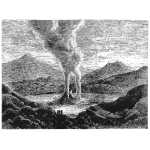
View of the Crater of South Lake in a State of Eruption, from the Crest of the North Lake
Click Thumbnail for full-size Illustration
When you have seen the fiery lakes you will recognize a crater at sight, and every part of Hawaii and of the other islands will have a new interest for you; for all are full of craters, and from Kilauea to the sea you may trace several lines of craters, all extinct, but all at some time belching forth those interminable lava streams over which you ride by the way of the Puna coast for nearly seventy miles back to Hilo.
I advise you to take this way back. Almost the whole of it is a land of desolation. A narrow trail across unceasing beds of lava, a trail which in spots was actually hammered down to make it smooth enough for horses' feet, and outside of whose limits in most places your horse will refuse to go, because he knows it is too rough for beast or man: this is your road. Most of the lava is probably very ancient, though some is quite recent; and ferns and guava bushes and other scanty herbage grow through it.
In some of the cavernous holes, which denote probably ancient cones or huge lava bubbles, you will see a cocoa-nut-tree or a pandanus trying to subsist; and by-and-by, after a descent to the sea-shore, you are rewarded with the pleasant sight of groves of cocoa-nuts and umbrageous arbors of pandanus, and occasionally with a patch of green.
Almost the whole of the Puna coast is waterless. From the Volcano House you take with you not only food for the journey back to Hilo, but water in bottles; and your thirsty animals get none until you reach the end of your first day's journey, at Kaimu. Here, also, you can send a more than half-naked native into the trees for cocoa-nuts, and drink your fill of their refreshing milk, while your jaded horses swallow bucketfuls of rain-water.
It will surprise you to find people living among the lava, making potato-patches in it, planting coffee and some fruit-trees in it, fencing in their small holdings, even, with lava blocks. Very little soil is needed to give vegetation a chance in a rainy reason, and the decomposed lava makes a rich earth. But except the cocoa-nut which grows on the beach, and seems to draw its sustenance from the waves, and the sweet-potato, which does very well among the lava, nothing seems really to thrive.
It will add much to the pleasure of your journey to Kilauea if you carry with you, to read upon the spot and along the road, Brigham's valuable Memoir on the Hawaiian Volcanoes. With this in hand, you will comprehend the nature, and know also the very recent date of some important changes, caused by earthquakes and lava flows, on the Puna coast. Near and at Kaimu, for instance, there has been an apparent subsidence of the land, which is supposed in reality, however, I believe, to have been caused rather by the breaking off of a vast lava ledge or overhang, on which, covered as it was with earth and trees, a considerable population had long lived. In front of the native house in which you will sleep, at Kaimu, part of a large grove of cocoa-nut-trees was thus submerged, and you may see the dead stumps still sticking up out of the surf.
Kaimu is twenty-five miles from the Volcano House. The native house at which you will pass the night is clean, and you may there enjoy the novelty of sleeping on Hawaiian mats, and under the native cover of tapa. You must bring with you tea or coffee, sugar, and bread, and such other food as is necessary to your comfort. Sweet-potatoes and bananas, and chickens caught after you arrive, with abundant cocoa-nuts, are the supplies of the place. The water is not good, and you will probably drink only cocoa-nut milk, until, fifteen miles farther on, at Captain Eldart's, you find a pleasant and comfortable resting-place for the second night, with a famous natural warm bath, very slightly mineral. Thence a ride of twenty-three miles brings you back to Hilo, all of it over lava, most of it through a sterile country, but with one small burst of a real paradise of tropical luxuriance, a mile of tall forest and jungle, which looks more like Brazil than Hawaii.
One advantage of returning by way of the Puna coast, rather than by the direct route from Kilauea, is that you have clear, bright weather all the way. The configuration of the coast makes Puna sunny while Hilo is rainy.
If you desire a longer ride than that by the Puna coast, you can cross the island, from the Volcano House, by way of Waiahino and Kapapala to Kauwaloa on the western coast, whence a schooner will bear you back to Honolulu. A brief study of the map of Hawaii in this volume will show the different routes suggested in this chapter.
Moreover, when you are at Kilauea, you have done something toward the ascent of Mauna Loa; and guides, provisions, and animals for that enterprise can be obtained at the Volcano House, as well as such ample details of the route that I will not here attempt any directions. It is not an easy ride; and you must carry with you warm clothing. A gentleman who slept at the summit in September, 1873, told me the ice made over two inches thick during the night.
If Mauna Loa is active, a traveler on the Islands ought by all means to see it; for Dr. Coan assures me that it is then one of the most terrific and grand sights imaginable. I did not visit it, as it was not active while I was on the Islands, though its fires were alive. The crater is a pit about three miles in circumference, with precipitous banks about two thousand feet deep. At the bottom is the burning lake, which has a curious habit of throwing up a jet, more or less constant, of fiery lava, to the height, this last summer, of four or five hundred feet from the surface of the lake. It is a fine sight, but, of course, somewhat distant. I am told that this jet has at times reached nearly to the summit level of the crater; and it must then have been a glorious spectacle.
Near Hilo are some pretty water-falls and several sugar plantations, to which you can profitably give a couple of days, and on another you should visit Cocoa-nut Island, and—as interesting a spot as almost any on the Islands—a little lagoon on the main-land near by, in which you may see the coral growing, and pick it up in lovely specimens with the stones upon which it has built in these shallow and protected waters. Moreover, the surf-beaten rocks near by yield cowries and other shells in some abundance; and I do not know anywhere of a pleasanter picnic day than that you can spend there.
Finally, Hilo is one of the very few places on these islands where you can see a truly royal sport—the surf-board. It requires a rough day and a heavy surf, but with a good day it is one of the finest sights in the world.
The surf-board is a tough plank about two feet wide and from six to twenty feet long, usually made of the bread-fruit-tree. Armed with these, a party of tall, muscular natives swim out to the first line of breakers, and, watching their chance to duck under this, make their way finally, by the help of the under-tow, into the smooth water far off: beyond all the surf. Here they bob up and down on the swell like so many ducks, watching their opportunity. What they seek is a very high swell, before which they place themselves, lying or kneeling on the surf-board. The great wave dashes onward, but as its bottom strikes the ground, the top, unretarded in its speed and force, breaks into a huge comber, and directly before this the surf-board swimmer is propelled with a speed which we timed and found to exceed forty miles per hour. In fact, he goes like lightning, always just ahead of the breaker, and apparently downhill, propelled by the vehement impulse of the roaring wave behind him, yet seeming to have a speed and motion of his own.
It is a very surprising sight to see three or four men thus dashed for nearly a mile toward the shore at the speed of an express train, every moment about to be overwhelmed by a roaring breaker, whose white crest was reared high above and just behind them, but always escaping this ingulfment, and propelled before it. They look, kneeling or lying on their long surf-boards, more like some curious and swift-swimming fish—like dolphins racing, as it seemed to me—than like men. Once in a while, by some mischance the cause of which I could not understand, the swimmer was overwhelmed; the great comber overtook him; he was flung over and over like a piece of wreck, but instantly dived, and re-appeared beyond and outside of the wave, ready to take advantage of the next. A successful shot launched them quite high and dry on the beach far beyond where we stood to watch. Occasionally a man would stand erect upon his surf-board, balancing himself in the boiling surf without apparent difficulty.
The surf-board play is one of the ancient sports of Hawaii. I am told that few of the younger generation are capable of it, and that it is thought to require great nerve and coolness even among these admirable swimmers, and to be not without danger.
In your journeys to the different islands you need to take with you, as part of your baggage, saddle and bridle, and all the furniture of a horse. You can hire or buy a horse anywhere very cheaply; but saddles are often unattainable, and always difficult to either borrow or hire. "You might as well travel here without your boots as without your saddle," said a friend to me; and I found it literally true, not only for strangers, but for residents as well. Thus you may notice that the little steamer's hold, as she leaves Honolulu, contains but few trunks; but is crowded with a considerable collection of saddles and saddle-bags, the latter the most convenient receptacles for your change of clothing.
Riding on Hawaii is often tiresome, even to one accustomed to the saddle, by reason of the slow pace at which you are compelled to move. Wherever you stop, for lunch or for the night, if there are native people near, you will be greatly refreshed by the application of what they call "lomi-lomi." Almost everywhere you will find some one skillful in this peculiar and, to tired muscles, delightful and refreshing treatment.
To be lomi-lomied, you lie down upon a mat, loosening your clothing, or undressing for the night if you prefer. The less clothing you have on the more perfectly the operation can be performed. To you thereupon comes a stout native, with soft, fleshy hands but a strong grip, and, beginning with your head and working down slowly over the whole body, seizes and squeezes with a quite peculiar art every tired muscle, working and kneading with indefatigable patience, until in half an hour, whereas you were sore and weary and worn-out, you find yourself fresh, all soreness and weariness absolutely and entirely removed, and mind and body soothed to a healthful and refreshing sleep.
The lomi-lomi is used not only by the natives, but among almost all the foreign residents; and not merely to procure relief from weariness consequent on overexertion, but to cure headache, to relieve the aching of neuralgic or rheumatic pains, and, by the luxurious, as one of the pleasures of life. I have known it to relieve violent headache in a very short time. The old chiefs used to keep skillful lomi-lomi men and women in their retinues; and the late king, who was for some years too stout to take exercise, and was yet a gross feeder, had himself lomi-lomied after every meal, as a means of helping his digestion.
It is a device for relieving pain or weariness which seems to have no injurious reaction and no drawback but one—it is said to fatten the subjects of it.
CHAPTER III.
MAUI, AND THE SUGAR CULTURE.
Maui lies between Oahu and Hawaii, and is somewhat larger than the first-named island. It contains the most considerable sugar-plantations, and yields more of this product than any one of the other islands. It is notable also for possessing the mountain of Haleakala, an extinct volcano ten thousand feet high, which has the largest crater in the world—a monstrous pit, thirty miles in circumference, and two thousand feet deep.
There is some reason to believe that Maui was originally two islands, the northern and southern parts being joined together by an immense sandy plain, so low that in misty weather it is hardly to be distinguished from the ocean; and some years ago a ship actually ran aground upon it, sailing for what the captain imagined to be an open passage.
Maui has also the famous Wailuku Valley, a picturesque gorge several miles deep, and giving you a very fair example of the broken, verdure-clad, and now lonely valleys of these islands; which are in reality steep, narrow cañons, worn out of the mountains by the erosion of water. The old Hawaiians seem to have cared little how difficult a piece of country was; they not only made their taro patches in the streams which roar at the bottoms of such gorges, but they fought battles among the precipices which you find at the upper ends of these valleys, where the defeated usually met their deaths by plunging down into the stream far below.
After seeing a live or burning crater like Kilauea, Haleakala, I thought, would be but a dull sight; but it is, on the contrary, extremely well worth a visit. The islands have no sharp or angular volcanic peaks. Mauna Loa and Mauna Kea, on Hawaii, though 14,000 feet high, are mere bulbs—vast hills, not mountains; and the ascent to the summit of Haleakala, though you surmount 10,000 feet, is neither dangerous nor difficult. It is tedious, however, for it involves a ride of about twelve miles, mostly over lava, uphill. It is best to ride up during the day, and sleep at or near the summit, where there are one or two so-called caves in the lava, broken lava-bubbles in fact, sufficiently roomy to accommodate several persons. You must take with you a guide, provisions, and blankets, for the nights are cold; and you find near the summit water, wood enough for a small fire, and forage for your horses. Each person should have water-proof clothing, for it is very likely to rain, at least on the Makawao side.
The great crater is best seen at sunrise, and, if you are so fortunate as to have a tolerably clear sky, you may see, lying far away below you, almost all of the islands. Hawaii lies far enough away to reveal its entire outline, with Mauna Loa and Mauna Kea rising near either end, and the depression near which lies Kilauea in the middle. The cloud effects at sunrise and sunset are marvelous, and alone repay the ascent.
But the crater itself, clear of fog and clouds in the early morning, and lighted up by the rising sun, is a most surprising sight. It is ten miles in diameter, and the bottom lies 2000 feet below where you stand. The vast irregular floor contains more than a dozen subsidiary craters or great cones, some of them 750 feet high, and nearly as large as Diamond Head. At the Kaupo and Koolau gaps, indicated on the map, the lava is supposed to have burst through and made its way down the mountain sides. The cones are distinctly marked as you look down upon them; and it is remarkable that from the summit the eye takes in the whole crater, and notes all its contents, diminished of course by their great distance. Not a tree, shrub, or even tuft of grass obstructs the view.
To describe such a scene is impossible. A study of the map, with the figures showing elevations, will give you a better idea of it than a long verbal description. It is an extraordinarily desolate scene. A few wild goats scramble over the rocks, or rush down the nearly perpendicular cliff; occasionally a solitary bird raises its harsh note; the wind howls fiercely; and as you lie under the lee of a mass of lava, taking in the scene and picking out the details as the rising sun brings them out one by one, presently the mist begins to pour into the crater, and often by ten o'clock fills it up completely.
The natives have no tradition of Haleakala in activity. There are signs of several lava flows, and of one in particular, clearly much more recent than the others. It must have presented a magnificent and terrible sight when it was in full activity. I did not ride into the crater, but it is possible to do so, and the natives have a trail, not much used, by which they pass. If you descend, be careful not to leave or lose this trail, for in many parts your horse will not be able to get back to it if you suffer him to stray off even a few yards, the lava is so sharp and jagged. As you descend the mountain on the Makawao side you will notice two finely shaped craters on the side of the mountain, which also in their time spewed out lava. Nearer the coast your eye, become familiar with the peculiar shape of these cones or craters, will notice yet others; and, indeed, to appreciate the peculiarities of Sandwich Island scenery, in which extinct craters and cones of all sizes have so great a part, it is necessary to have visited Kilauea and Haleakala. The latter name, by-the-way, means "House of the Sun;" and as you watch the rising sun entering and apparently taking possession of the vast gloomy depths, you will think the name admirably chosen.
If you carry a gun you are likely to have a shot at wild turkeys on your way up or down. It is remarkable that many of our domestic animals easily become wild on the islands. There are wild goats, wild cats, wild chickens and turkeys; the cattle run wild; and on Hawaii one man at least has been killed and torn to pieces by wild dogs, which run in packs in some parts of the island.
Sugar plantations are found on all four of the larger islands; and on all of them there are successful examples of this enterprise; but Maui contains, I believe, the greatest number, and is thought to be the best fitted for the business. It is on this island, therefore, that the curious traveler can see this industry under its most favorable aspects. There is no doubt that for the production of sugar these islands offer some extraordinary advantages.
I have seen a field of thirty acres which two years ago produced nearly six tons of sugar to the acre. Four tons per acre is not a surprising crop; and, from all I can hear, I judge that two and a half tons per acre may be considered a fair yield. The soil, too, with proper treatment, appears to be inexhaustible. The common custom is to take off two crops, and then let the field lie fallow for two years; but where they irrigate even this is not always done. There is no danger of frost, as in Louisiana, and cane is planted in some part of the islands in almost every month of the year. In Lahaina it matures in from fourteen to sixteen months; in some districts it requires eighteen months; and at greater altitudes even two years.
But under all the varying circumstances, whether it is irrigated or not, whether it grows on bottoms or on hill slopes, in dry or in damp regions, everywhere the cane seems to thrive, and undoubtedly it is the one product of the islands which succeeds. A worm, which pierces the cane near the ground and eats out the pith, has of late, I am told, done some damage, and in some parts the rat has proved troublesome. But these evils do not anywhere endanger or ruin the crop, as the blight has ruined the coffee culture and discouraged other agricultural ventures. The sugar product of the islands has constantly increased. In 1860 they exported 1,444,271 pounds of sugar; in 1864, 10,414,441 pounds; in 1868, 18,312,926 pounds; and in 1871, 21,760,773 pounds of sugar.
What is remarkable is that, with this rapid increase in the production of sugar, you hear that the business is unprosperous; and if to this you reply that planters, like farmers, are hard to satisfy, they show you that the greater number of the plantations have at some time been sold by the sheriff, some of them more than once, and that, in fact, only six or seven are to-day in the hands of their founders.
I do not doubt that there has been bad management on many plantations, and that this accounts in part for these failures, by which many hundred thousand dollars have been lost. For the advantages of the sugar planter on these islands are very decided. He has not only, as I showed you above, a favorable climate and an extraordinarily fertile soil, but he has a laboring population, perhaps the best, the most easily managed, the kindliest, and—so far as habits affect the steadiness and usefulness of the laborer—the least vicious in the world. He does not have to pay exorbitant wages; he is not embarrassed to feed or house them, for food is so abundant and cheap that economy in its distribution is of no moment; and the Hawaiian is very cheaply housed.
But bad management by no means accounts for all the non-success. There are some natural disadvantages serious enough to be taken into the account. In the first place, you must understand that the rain-fall varies extraordinarily. The trade-wind brings rain; the islands are bits of mountain ranges; the side of the mountain which lies toward the rain-wind gets rain; the lee side gets scarcely any. At Hilo it rains almost constantly; at Lahaina they get hardly a shower a year. At Captain Makee's, one of the most successful plantations on Maui, water is stored in cisterns; at Mr. Spencer's, not a dozen miles distant, also one of the successful plantations, which lies on the other side of Mount Haleakala, they never have to irrigate. Near Hilo the long rains make cultivation costly and difficult; but the water is so abundant that they run their fire-wood from the mountains and their cane from the fields into the sugar-houses in flumes, at a very great saving of labor. Near Lahaina every acre must be irrigated, and this work proceeds day and night in order that no water may run to waste.
Then there is the matter of shipping sugar. There are no good ports except Honolulu. Kaului on Maui, Hanalei and Nawiliwili on Kauai, and one or two plantations on Oahu, have tolerable landings. But almost everywhere the sugar is sent over vile roads to a more or less difficult landing, whence it is taken in launches to the schooners which carry it to Honolulu, where it is stored, coopered, and finally reshipped to its market. Many landings are made through the surf, and I remember one which, last spring, was unapproachable by vessel or boat for nearly four weeks.
Each sugar planter has, therefore, problems of his own to solve. He can not pattern on his neighbors. He can not base his estimate on theirs. He can not be certain even, until he has tried, which of the ten or a dozen varieties of cane will do best on his soil. He must look out for wood, which is by no means abundant, and is often costly to bring down from the mountain; he must look out for his landing; must see that taro grows near at hand; must secure pasture for his draught cattle: in short, he must consider carefully and independently many different questions before he can be even reasonably sure of success. And if, with all this uncertainty, he embarks with insufficient capital, and must pay one per cent. a month interest, and turn his crop over to an agent in Honolulu, who is his creditor, and who charges him five per cent. for handling it, it will not be wonderful to any business man if he fails to grow rich, or if even he by-and-by becomes bankrupt. Many have failed. Of thirty-four plantations, the number worked in all the islands at this time, only six or seven are in the hands of their founders. Some, which cost one hundred thousand dollars, were sold by the sheriff for fifteen or eighteen thousand; some, which cost a quarter of a million, were sold for less than a hundred thousand.
If you speak with the planters, they will tell you that their great difficulty is to get a favorable market; that the duty on their sugar imported into San Francisco eats up their profits; and that the only cure—the cure-all, I should say, for all the ills they suffer—is a treaty with the United States, which shall admit their product duty free. Of course any one can see that if the sugar duty were remitted to them, the planters would make more money, or would lose less. An ingenuous planter summed up for me one day the whole of that side of the case, by saying, "If we had plenty of labor and a free market for our sugar, we should be thoroughly satisfied."
But I am persuaded that, as there are planters now who are prosperous and contented, and who make handsome returns even with the sugar duty against them, so, if that were removed, there would be planters who would continue their regular and slow march toward bankruptcy; and for whom the remitted duty would be but a temporary respite, while it would deprive them of a cheap and easy way to account for their failure. Wherever on the islands I found a planter living on his own plantation, managing it himself, and out of debt, I found him making money, even with low prices for his sugar, and even if the plantation itself was not favorably placed; not only this, but I found plantations yielding steady and sufficient profits, under judicious management, which in previous hands became bankrupt. But on the other hand, where I found a plantation heavily encumbered with debt and managed by a superintendent, the owner living elsewhere, I heard usually, though not always, complaints of hard times. If a sugar planter has his land and machinery heavily mortgaged at ten or twelve per cent interest; if he must, moreover, borrow money on his crop in the field to enable him to turn that into sugar; if then he sends the product to an agent in Honolulu, who charges him five per cent. for shipping it to San Francisco; and if in San Francisco another agent charges him five per cent. more, on the gross returns including freight and duty, for selling it; if besides all this the planter buys his supplies on credit, and is charged one per cent. a month on these, compounded every three months until it is paid, and pays almost as much freight on his sugar from the plantation to Honolulu as from there to its final market—it is highly probable that he will, in the course of time, fail.
There are not many legitimate enterprises in the world which would bear such charges and leave a profit to the manager. But it is on this system that the planting of sugar has been, to a large extent, carried on for years in the Islands. Under it a good deal of money has been made, but not by the planters. Nor is this essentially unjust. In the majority of cases, planters began rashly with small means, and had to borrow largely to complete their enterprises and get to work. The capitalist of course took a part of the profits as interest. But the capitalist was in many cases also the agent and store-keeper in Honolulu; and he shaved off percentages—all in the way of business—until the planter was really no more than the foreman of his agent and creditor. When, under such circumstances, a planter complained that he did not make the fortune he anticipated, and reasoned that therefore sugar planting in the Islands is unprofitable, he seemed to me to speak beside the question—for his agent and creditor, his employer in fact, made no complaint: he always made money; and as he had invested the money to carry on the enterprise, this was but the natural result.
The planters make a grave mistake in not acting together and advising together on their most important interests. There are so few of them that it should be easy to unite; and yet for lack of concerted action they suffer important abuses to go on. For instance, it is a serious loss to the planter that when he ships or engages a hand he must pay a large "advance," amounting usually to at least half a year's pay. This custom is hurtful to the laborer, who wastes it, and it inflicts a serious loss upon the planter. Suppose he employs a hundred men, and pays fifty dollars advance, he invests at once five thousand dollars for which he gets no interest, though if, as is probable, he borrowed it, he must pay one per cent. a month. This abuse could be abolished in a day by the simple announcement that no planter would hereafter pay more than ten dollars advance. But it has gone on for years, and the sum paid gets higher every year merely by the planters outbidding each other.
Again, it is possible to ship sugar from some of the Islands direct to San Francisco, and for but little more than is now paid for shipping it to Honolulu. Half a dozen planters on Hawaii or Maui, clubbing together, could easily get a ship or half a dozen ships to come for their sugar, and thus save five per cent. on their gross returns, now paid to agents. But this is not done, partly because so many planters are in need of money, which they borrow in Honolulu, with the understanding that they will submit their produce to the management of agents there.
Again, the planters err, I think, in not giving personal study to the question of a market for their sugar. They leave this to the agents to manage. No doubt these gentlemen are competent; but it is easy to see that their interests may be somewhat different from those of the planter. For instance, some years ago an arrangement was offered by the San Francisco sugar refineries by which these agreed to take two-thirds of the product of the plantations in crude sugar, to furnish bags to contain this product, and to pay cash for it in Honolulu. Under this system the planter was saved the heavy expense of sugar kegs, and the cost of two agencies of five per cent. each, besides getting cash in Honolulu, whereas now his sugar is usually sold at three months in San Francisco, and he probably loses six months' interest, reckoning from the time his sugar leaves the plantation. This arrangement, several planters told me, was profitable to them; but it was discontinued—it was not to the advantage of the agents; its discontinuance was no doubt a blunder for the planters. Moreover, the Australian market has been too long neglected; but the advantage of possessing two markets instead of one is too obvious to require statement.
It is a reasonable conclusion, from all the facts in the case, that sugar planting can be carried on at a fair and satisfactory profit in the Hawaiian Islands, wherever skill and careful personal attention are given, and due economy enforced by a planter who has at the same time sufficient capital to carry on the business. The example of Captain Makee and Mr. A.H. Spencer on Maui, of Mr. Isenberg on Kauai and others sufficiently prove this.
If I seem to have given more space to this sugar question than it appears to deserve at the hands of a passing traveler, it is because sugar enters largely into the politics of the Islands. It is the sugar interest which urges the offer of Pearl River to the United States in exchange for a treaty of reciprocity; and it is when sugar is low-priced at San Francisco that the small company of annexationists raises its voice, and sometimes threatens to raise its flag.
There is room on the different islands for about seventy-five or eighty more plantations on the scale now common; and there are, I think, still excellent opportunities for making plantations. The sugar lands unoccupied are not high-priced; and men skilled in this industry, and with sufficient capital, can do well there, and live in a delightful climate and among pleasant society, in a country where, as I have before said, life and property are more absolutely secure than anywhere else in the world. But I strongly advise every one to avoid debt. It has been the curse of the planters, even of those who have kept out of debt, for it has prevented such unity of action among them as must have before this enabled them to effect important improvements. For instance, were they out of debt there is no reason that I can see why they should not succeed in making their market in Honolulu, and drawing purchasers thither instead of sending their sugar to far-off markets at their own risk and expense. If ships can afford to sail in ballast to more distant islands for guano, calling at Honolulu on the way, it is reasonable to suppose they could afford to come thither for the more valuable sugar cargoes.
The planters err, I think, in not planting the mountain sides, wherever these are accessible and have soil, with trees. The forests of the country are rapidly disappearing, especially from the higher plains and the grass-bearing slopes. Not only is the wood cut for burning, but the cattle browse down the young growth; and a pestilent grub has of late attacked the older trees and destroyed them in great numbers. Already complaints are heard of the greater dryness and infertility of certain localities, which I do not doubt comes from suffering the ground to become bare. At several points I was told that the streams were permanently lower than in former years—of course because evaporation goes on more rapidly near their head waters now that the ground is bare. But little care or forethought is exercised in such matters, however. A few extensive plantations of trees have been made, notably by Captain Makee on Maui, who has set out a large number of Australian gum trees. The universal habit of letting cattle run abroad, and the dearness of lumber for fencing, discourages tree planting, which yet will be found some day one of the most profitable investments in the islands, I believe; and I was sorry to see in many places cocoa-nut groves dying out of old age and neglect, and no young trees planted to replace them.
It remains to describe to you the "contract labor" system by which the sugar-plantations are carried on. This has been frequently and, as it seems to me, unjustly abused as a system of slavery. The laborers hire themselves out for a stated period, usually, in the case of natives, for a year, and in the case of Chinese for five years. The contract runs in English and in Hawaiian or Chinese, and is sufficiently simple. Thus:
"This Agreement, made and entered into this —— day of ——, A.D. 18——, by and between the owners of the —— plantation, in the island of ——, party of the first part, and —— ——, party of the second part, witnesseth: "I. The said party of the second part promises to perform such labor upon the —— plantation, in the district of ——, island of ——, as the said party of the first part shall direct, and that he will faithfully and punctually perform the same as becomes a good workman, and that he will obey all lawful commands of the said party of the first part, their agents or overseers, during the term of —— months, each month to consist of twenty-six working days. "II. The party of the first part will well and truly pay, or cause to be paid, unto the said party of the second part, at the end of each month during which this contract shall remain in force, compensation or wages at the rate of —— dollars for each month, if said party of the second part shall well and truly perform his labor as aforesaid."
The law requires that this contract shall be signed before a notary public. The wages are usually eight dollars per month and food, or eleven dollars per month without food; from which you will see that three dollars per month will buy sufficient poi, beef, and fish to support a native laborer in these islands. The engagement is entirely voluntary; the men understand what they contract to do, and in all the plantations where they are well treated they re-enlist with great regularity. The vicious custom of "advances" mentioned above has become a part of the system; it arose, I suppose, from the fact that the natives who shipped as whalemen received advance pay; and thus the plantation laborers demanded it too. The laborers are commonly housed in detached cottages, and live with their families, the women forming an important, irregular laboring force at seasons when the work is hurried. But they are not "contract" laborers, but paid by the day. It has been found the best plan on most of the plantations to feed the people, and food is so cheap that it is supplied without stint.
This system has been vigorously, but, I believe, wrongly, attacked. The recent census is an uncommonly barren document; but there is strong reason to believe that while there is a general decrease in the population, on the plantations there is but little if any decrease. In fact, the Hawaiian living in his valley on his kuliana or small holding, leads an extremely irregular life. He usually sups at midnight, sleeps a good deal during the day, and has much idle time on his hands. On the plantations he works regularly and not too hard, eats at stated intervals, and sleeps all night. This regularity conduces to health. Moreover, he receives prompt and sufficient medical attendance, he lives a more social and interesting life, and he is as well fed, and mostly better lodged. There are very few instances of abuse or cruelty; indeed, a plantation manager said to me, "If I were to wrong or abuse one of my men, he would persuade a dozen or twenty others not to re-enlist when their terms are out, and would fatally embarrass me;" for it is not easy to get laborers.
There is good reason to believe, therefore, that the plantation laborers are healthier, more prosperous, and just as happy as those who live independently; and it is a fact that on most of the islands the greater part of the younger people are found on the plantations. Churches are established on or very near all the sugar estates, and the children are rigorously kept at school there as elsewhere. The people take their newspaper, discuss their affairs, and have usually a leader or two among the foremen. On one plantation one of the foremen in the field was pointed out to me: he was a member of the Legislature.
There is a good deal of complaint of a scarcity of labor. If more plantations were opened it would be necessary to import laborers; but for the present, it seems to me, the supply is not deficient. Doubtless, however, many planters would extend their operations if they could get workmen readily. Chinese have been brought over, though not in great numbers; and of late the absurd and cruel persecution of these people in California has driven several hundred to take refuge in the Islands, where they are kindly treated and can live comfortably.
The machinery used in the sugar-houses is usually of the best; the larger plantations all use vacuum-pans; and the planters are usually intelligent gentlemen, familiar with the best methods of producing sugar, and with the latest improvements. Yet it is a question whether the expensive machinery is not in the long run a disadvantage, as it disables them from profitably making those low grades of sugar which can be cheaply turned out with the help of an "open train," and which appear to have, in these days, the most ready sale and the best market.

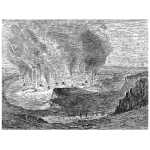
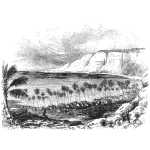
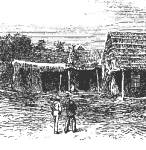
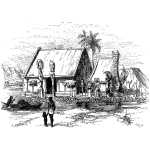
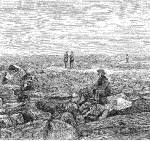
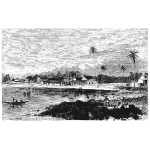
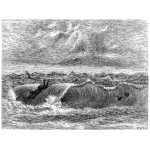
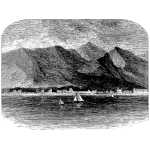
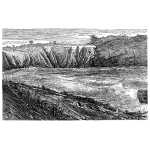
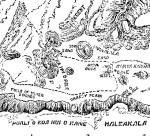
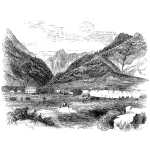
No comments:
Post a Comment